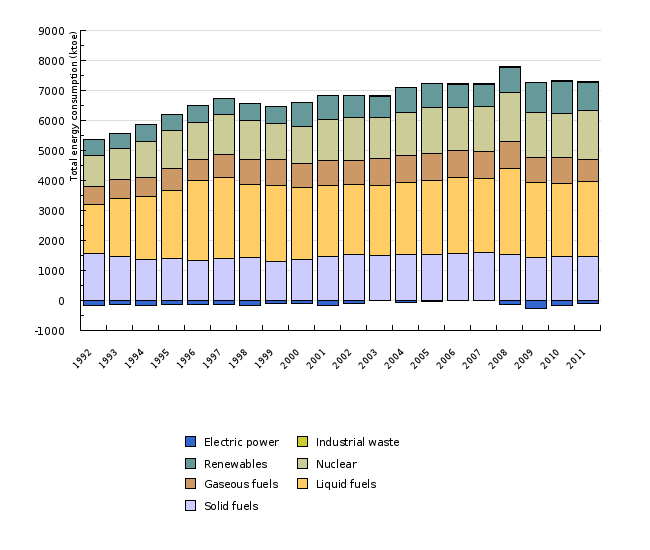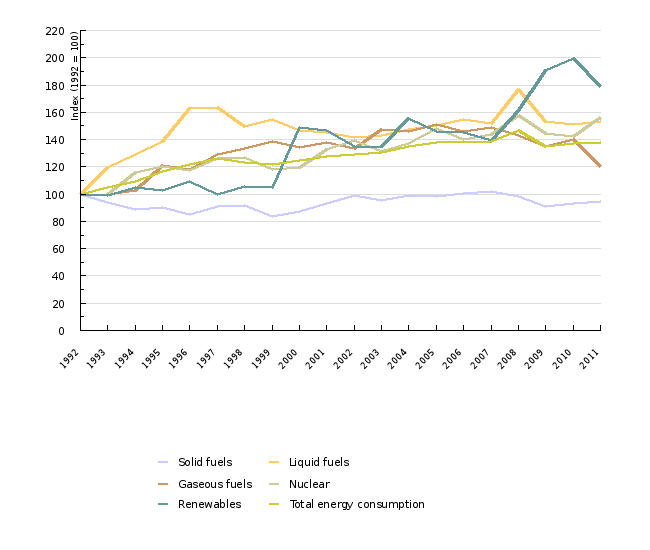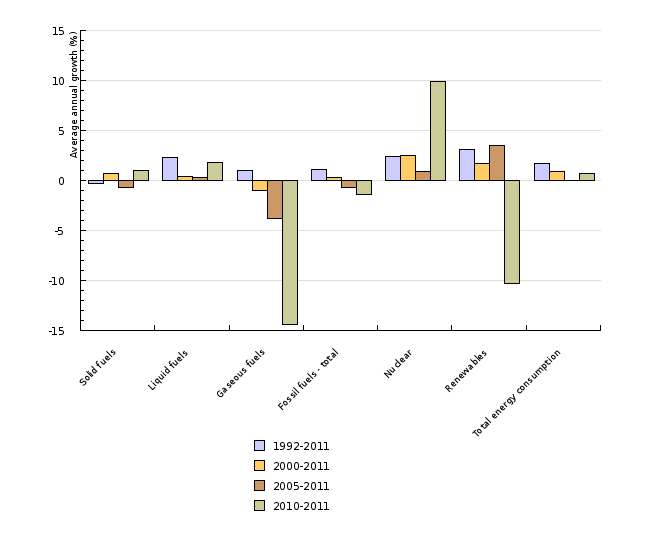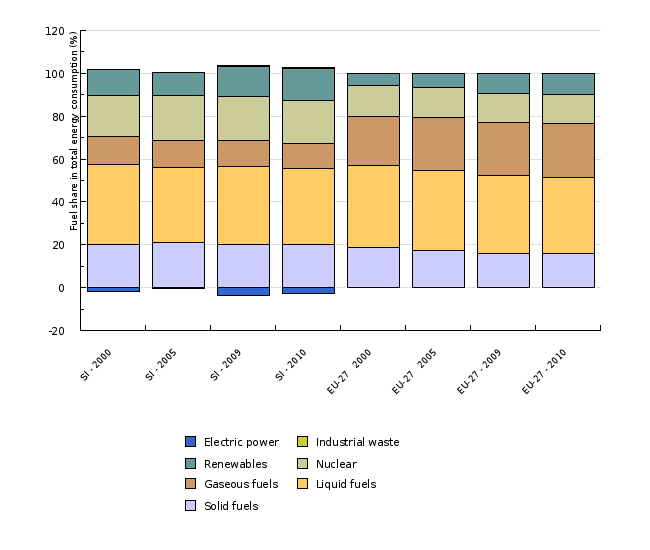[EN16] Total energy consumption by fuels

Key message

In 2011, total energy consumption increased for 0.7% and reached the peak after the year 2008. The share of liquid fuels was the highest, followed by nuclear energy, solid fuels, renewable energy sources and gaseous fuels. In 2011, the shares of nuclear energy, liquid fuels and solid fuels increased. Total energy consumption growth in Slovenia after the year 2000 was higher than in the EU-27.
Definition
Total energy consumption (sometimes also referred to as energy supply) is the amount of energy necessary to satisfy the energy needs of a country. It is calculated as the sum of the total energy consumption in the form of solid, liquid, gaseous, nuclear fuels and renewable energy sources and the net import of electricity.
Charts
Statistical Office of the Republic of Slovenia, 2012;
Jožef Stefan Institute, 2012.
| 1992 | 1993 | 1994 | 1995 | 1996 | 1997 | 1998 | 1999 | 2000 | 2001 | ||
|---|---|---|---|---|---|---|---|---|---|---|---|
| Solid fuels | ktoe | 1558.6 | 1467.7 | 1377.8 | 1407.3 | 1329.4 | 1415.7 | 1431.3 | 1308.1 | 1358.7 | 1450.2 |
| Liquid fuels | ktoe | 1631.2 | 1944.3 | 2100 | 2261.8 | 2656.8 | 2670.3 | 2443.3 | 2522.4 | 2392.1 | 2371.3 |
| Gaseous fuels | ktoe | 615.3 | 614.6 | 629.7 | 745.8 | 728.5 | 794.8 | 821 | 853.7 | 825.3 | 849.7 |
| Nuclear | ktoe | 1034.7 | 1030.8 | 1200.9 | 1245.2 | 1210.8 | 1307.7 | 1313.7 | 1223.6 | 1240.5 | 1369.8 |
| Renewables | ktoe | 529.7 | 523.4 | 555.4 | 542.4 | 579.4 | 529.4 | 560.4 | 554.8 | 787.7 | 776.3 |
| Industrial waste | ktoe | 0 | 0 | 0 | 0 | 0 | 0 | 0 | 0 | 0.3 | 0.2 |
| Electric power | ktoe | -155.9 | -121.9 | -166.3 | -142 | -142.8 | -145.8 | -165 | -115 | -113.6 | -152.4 |
| Total energy consumption | ktoe | 5213.6 | 5458.9 | 5697.5 | 6060.5 | 6362.2 | 6572.1 | 6404.7 | 6347.4 | 6491 | 6665.1 |
| 2002 | 2003 | 2004 | 2005 | 2006 | 2007 | 2008 | 2009 | 2010 | 2011 | ||
| Solid fuels | ktoe | 1548.2 | 1489.2 | 1538.2 | 1532.4 | 1569.1 | 1586.5 | 1528.8 | 1420.5 | 1453.7 | 1468.8 |
| Liquid fuels | ktoe | 2303.5 | 2333.5 | 2403.3 | 2453.3 | 2523.4 | 2479.3 | 2878.6 | 2504.3 | 2458.4 | 2502.5 |
| Gaseous fuels | ktoe | 819.6 | 906.7 | 898.5 | 929 | 899.2 | 914.4 | 878.2 | 831.1 | 862.3 | 737.8 |
| Nuclear | ktoe | 1440.4 | 1356.7 | 1422.4 | 1533.1 | 1445.6 | 1483.9 | 1634.5 | 1495.3 | 1474 | 1619.3 |
| Renewables | ktoe | 715.4 | 713.9 | 821.7 | 773.9 | 767.9 | 737.1 | 853.7 | 1011.7 | 1058.2 | 948.9 |
| Industrial waste | ktoe | 0.1 | 8.7 | 10.4 | 13 | 15.9 | 12.8 | 14.5 | 19.8 | 23.3 | 29.3 |
| Electric power | ktoe | -97.5 | 14.1 | -65 | -27.9 | 3.8 | 19.6 | -137.5 | -263 | -179.9 | -108.5 |
| Total energy consumption | ktoe | 6729.6 | 6822.8 | 7029.5 | 7206.7 | 7224.9 | 7233.6 | 7650.9 | 7019.7 | 7150 | 7198.1 |
Statistical Office of the Republic of Slovenia, 2012; Jožef Stefan Institute, 2012.
| 1992 | 1993 | 1994 | 1995 | 1996 | 1997 | 1998 | 1999 | 2000 | 2001 | ||
|---|---|---|---|---|---|---|---|---|---|---|---|
| Solid fuels | ktoe | 1559 | 1468 | 1378 | 1407 | 1329 | 1416 | 1431 | 1308 | 1359 | 1450 |
| Liquid fuels | ktoe | 1631 | 1944 | 2100 | 2262 | 2657 | 2670 | 2443 | 2522 | 2392 | 2371 |
| Gaseous fuels | ktoe | 615 | 615 | 630 | 746 | 729 | 795 | 821 | 854 | 825 | 850 |
| Nuclear | ktoe | 1035 | 1031 | 1201 | 1245 | 1211 | 1308 | 1314 | 1224 | 1241 | 1370 |
| Renewables | ktoe | 530 | 523 | 555 | 542 | 579 | 529 | 560 | 555 | 788 | 776 |
| Industrial waste | ktoe | 0 | 0 | 0 | 0 | 0 | 0 | 0 | 0 | 0 | 0 |
| Electric power | ktoe | -156 | -122 | -166 | -142 | -143 | -146 | -165 | -115 | -114 | -152 |
| Total energy consumption | ktoe | 5214 | 5459 | 5698 | 6060 | 6362 | 6572 | 6405 | 6347 | 6491 | 6665 |
| Solid fuels | Index (1992 = 100) | 100 | 94 | 88 | 90 | 85 | 91 | 92 | 84 | 87 | 93 |
| Liquid fuels | Index (1992 = 100) | 100 | 119 | 129 | 139 | 163 | 164 | 150 | 155 | 147 | 145 |
| Gaseous fuels | Index (1992 = 100) | 100 | 100 | 102 | 121 | 118 | 129 | 133 | 139 | 134 | 138 |
| Nuclear | Index (1992 = 100) | 100 | 100 | 116 | 120 | 117 | 126 | 127 | 118 | 120 | 132 |
| Renewables | Index (1992 = 100) | 100 | 99 | 105 | 102 | 109 | 100 | 106 | 105 | 149 | 147 |
| Total energy consumption | Index (1992 = 100) | 100 | 105 | 109 | 116 | 122 | 126 | 123 | 122 | 125 | 128 |
| 2002 | 2003 | 2004 | 2005 | 2006 | 2007 | 2008 | 2009 | 2010 | 2011 | ||
| Solid fuels | ktoe | 1548 | 1489 | 1538 | 1532 | 1569 | 1587 | 1529 | 1420 | 1454 | 1469 |
| Liquid fuels | ktoe | 2303 | 2333 | 2403 | 2453 | 2523 | 2479 | 2879 | 2504 | 2458 | 2502 |
| Gaseous fuels | ktoe | 820 | 907 | 899 | 929 | 899 | 914 | 878 | 831 | 862 | 738 |
| Nuclear | ktoe | 1440 | 1357 | 1422 | 1533 | 1446 | 1484 | 1634 | 1495 | 1474 | 1619 |
| Renewables | ktoe | 715 | 714 | 822 | 774 | 768 | 737 | 854 | 1012 | 1058 | 949 |
| Industrial waste | ktoe | 0 | 9 | 10 | 13 | 16 | 13 | 15 | 20 | 23 | 29 |
| Electric power | ktoe | -98 | 14 | -65 | -28 | 4 | 20 | -138 | -263 | -180 | -109 |
| Total energy consumption | ktoe | 6730 | 6823 | 7030 | 7207 | 7225 | 7234 | 7651 | 7020 | 7150 | 7198 |
| Solid fuels | Index (1992 = 100) | 99 | 96 | 99 | 98 | 101 | 102 | 98 | 91 | 93 | 94 |
| Liquid fuels | Index (1992 = 100) | 141 | 143 | 147 | 150 | 155 | 152 | 176 | 154 | 151 | 153 |
| Gaseous fuels | Index (1992 = 100) | 133 | 147 | 146 | 151 | 146 | 149 | 143 | 135 | 140 | 120 |
| Nuclear | Index (1992 = 100) | 139 | 131 | 137 | 148 | 140 | 143 | 158 | 145 | 142 | 157 |
| Renewables | Index (1992 = 100) | 135 | 135 | 155 | 146 | 145 | 139 | 161 | 191 | 200 | 179 |
| Total energy consumption | Index (1992 = 100) | 129 | 131 | 135 | 138 | 139 | 139 | 147 | 135 | 137 | 138 |
Statistical Office of the Republic of Slovenia, 2012;
Jožef Stefan Institute, 2012.
| Solid fuels | Liquid fuels | Gaseous fuels | Fossil fuels - total | Nuclear | Renewables | Total energy consumption | ||
|---|---|---|---|---|---|---|---|---|
| 1992-2011 | % | -0.3 | 2.3 | 1 | 1.1 | 2.4 | 3.1 | 1.7 |
| 2000-2011 | % | 0.7 | 0.4 | -1 | 0.3 | 2.5 | 1.7 | 0.9 |
| 2005-2011 | % | -0.7 | 0.3 | -3.8 | -0.7 | 0.9 | 3.5 | -0 |
| 2010-2011 | % | 1 | 1.8 | -14.4 | -1.4 | 9.9 | -10.3 | 0.7 |
Eurostat, 2012; Jožef Stefan Institute, 2012.
| SI - 2000 | SI - 2005 | SI - 2009 | SI - 2010 | EU-27 2000 | EU-27 2005 | EU-27 - 2009 | EU-27 - 2010 | ||
|---|---|---|---|---|---|---|---|---|---|
| Solid fuels | ktoe | 1305 | 1539 | 1425 | 1458 | 320845 | 317303 | 267918 | 279970 |
| Liquid fuels | ktoe | 2393 | 2556 | 2610 | 2573 | 661154 | 679346 | 623159 | 617094 |
| Gaseous fuels | ktoe | 826 | 929 | 832 | 863 | 393935 | 446003 | 416962 | 441796 |
| Nuclear | ktoe | 1228 | 1518 | 1480 | 1459 | 243841 | 257516 | 230767 | 236563 |
| Renewables | ktoe | 788 | 774 | 1006 | 1070 | 96980 | 116038 | 152729 | 172142 |
| Industrial waste | ktoe | 0 | 13 | 20 | 23 | 2819 | 1996 | 3423 | 3727 |
| Electric power | ktoe | -114 | -28 | -264 | -182 | 1685 | 972 | 1302 | 297 |
| Total energy consumption | ktoe | 6426 | 7301 | 7109 | 7264 | 1721259 | 1819174 | 1696260 | 1751589 |
| Solid fuels | % | 20.3 | 21.1 | 20 | 20.1 | 18.6 | 17.4 | 15.8 | 16 |
| Liquid fuels | % | 37.2 | 35 | 36.7 | 35.4 | 38.4 | 37.3 | 36.7 | 35.2 |
| Gaseous fuels | % | 12.9 | 12.7 | 11.7 | 11.9 | 22.9 | 24.5 | 24.6 | 25.2 |
| Nuclear | % | 19.1 | 20.8 | 20.8 | 20.1 | 14.2 | 14.2 | 13.6 | 13.5 |
| Renewables | % | 12.3 | 10.6 | 14.2 | 14.7 | 5.6 | 6.4 | 9 | 9.8 |
| Industrial waste | % | 0 | 0.2 | 0.3 | 0.3 | 0.2 | 0.1 | 0.2 | 0.2 |
| Electric power | % | -1.8 | -0.4 | -3.7 | -2.5 | 0.1 | 0.1 | 0.1 | 0 |
Goals
- minimum increase in the total energy consumption or increase lower than GDP growth;
- energy efficiency improvement for 20% until 2020
Methodology
Data for Slovenia
Objectives summarised by: Resolucija o Nacionalnem programu varstva okolja 2005-2012 (ReNPVO, Resolution on National Environmental Action Plan 2005-2012, Official Gazette of the RS, No. 2/06) and The EU climate and energy package.
Source database or source: SI-STAT and Eurostat.
Data administrator: Statistical Office of the Republic of Slovenia (Mojca Suvorov) and EUROSTAT.
Data acquisition date for the indicator: 14 November 2012
Methodology and frequency of data collection for the indicator: The data for the period 1992-1999 were calculated on the basis of data on the use of fuels in material units, which SORS communicated to EUROSTAT in the form of a Joint Annual Questionnaire, and data on calorific values for individual fuels, which were obtained in a joint questionnaire (solid fuels, gaseous fuels) and the SI-STAT Data Portal of the SORS (liquid fuels). For the period 2000-2008, the data of SORS were used; the data were also published on the SI-STAT Data Portal and were published on 25 September. The data Energy supply from the energy balance of Slovenia were used for the indicator. For the comparison of data for Slovenia with the EU data, EUROSTAT's data were used for the EU and Slovenia for the purposes of comparability; namely, EUROSTAT uses different calorific values. The data were obtained on EUROSTAT's website under the column »Environment and energy«. The data for the sector 100900 »Gross inland consumption« were used. The data are prepared on an annual basis, while the data for the previous year are available at the end of the current year.
Data processing methodology: Average annual rate of growth of the total energy consumption is calculated as [(last year/base year) ^ (1/number of years) –1]*100.
For the calculation of shares of individual fuels in the total energy consumption, the total energy consumption was the denominator and the use of individual fuel was the numerator. The indicator can be shown in relative (share of individual fuels in total energy consumption) or absolute units. For the indication in absolute units, the thousand tonnes of oil equivalent (ktoe) is used.
The annual growth for the indicator is sometimes shown as a percentage point. A percentage point is a unit used for the comparison of different rates of growth. A percentage point includes an absolute comparison calculated by the formula (nthis year)–(nlast year)=16 %–15 %=1 pp (for instance: if last year the growth was 15 % and this year 16 %, then this year the growth was higher by 1 percentage point). The difference in growth can also be expressed as a relative comparison using the formula [(nthis year/nlast year)*100]–100=[(16 %/15 %)*100]–100=6.7 %, where the growth is indicated in percentages.
Geographical coverage: The EU-15 includes old EU Member States (Austria, Belgium, Denmark, Finland, France, Germany, Greece, Ireland, Italy, Luxembourg, the Netherlands, Portugal, Spain, Sweden, the United Kingdom). The EU-10 includes members that joined the EU in 2004 (Cyprus, Czech Republic, Estonia, Hungary, Lithuania, Latvia, Malta, Poland, Slovenia, Slovakia). The EU-12 also includes, besides the EU-10, Romania and Bulgaria. The EU-27 includes EU-15 and EU-12; the EU-25 includes, on the other hand, the EU-15 and EU-10.
Information concerning data quality:
- Advantages and disadvantages of the indicator: The source of the basic information is one institution (SORS, EUROSTAT) for the entire time series. This provides a more efficient analysis of events in the considered period.
- Relevance, accuracy, robustness, uncertainty:
Reliability of the indicator (archival data): The reliability of data is estimated through the statistical differences in the energy balance due to the use of different calorific values. EUROSTAT uses the criterion that the energy balance is good if the statistical difference is smaller than 5 % of the energy consumption at the state level. In the used data, the statistical difference at the beginning of the period is 2.5 %, until 1999 around 1 %, and after that year lower than one percent. The unreliability of data is present especially due to the comparability over time, especially for the data on the use of renewable energy sources; namely, before 2000 these data were collected and processed by the ministry responsible for energy, and after 2000 by the Statistical Office of the Republic of Slovenia. There are not any official data on the energy consumption for the period 1992-1999 that would be directly comparable with the data for the period 2000-2008. In order to close in on such consistency as much as possible, the data were calculated on the basis of the data of SORS, which were communicated to EUROSTAT. Despite the fact that the data of the same institution were used, there were not any derogations in the comparison of calculations and official energy balances for the 2000-2007 period.
Uncertainty of the indicator (scenarios/projections): Scenarios and projections are not available.
- Overall assessment (1 = no major comments, 3 = data to be considered with reservation):
Relevance: 1
Accuracy: 2
Completeness over time: 2
Completeness over space: 1
Other sources and literature:
- EEA, 2012. Primary energy consumption by fuel (CSI 029/ENER 026).
- European Commission, 2006. COMMUNICATION FROM THE COMMISSION - Action Plan for Energy Efficiency: Realising the Potential (COM(2006)545).












